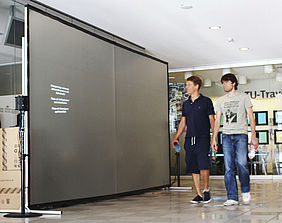CHI 2013 is the premier international conference on human-computer interaction. It is held this year in Paris on April 27 - May 2.
CHI 2013 has awarded two publications by the EIT ICT Labs’ Smart Spaces researchers Gilles Bailly, Jörg Müller, Constantin Schmidt and Robert Walter. Screenfinity won the best paper award and StrikeAPose got an honorable mention. This is already the second year in a row that our researchers are awarded with the best paper award at CHI.
Screenfinity – read while walking
Very large displays of even 80m lenght are being implemented more often and this could enable passers-by to read considerable amounts of content while walking. Screenfinity is a technique to rotate, translate, and zoom content in order to enable reading while passing by very large displays.
Screenfinity is comfortable to read when close, supports different content for different users, does not waste screen real estate and allows expert passers-by to read content while walking. A laboratory study shows that expert users are able to perceive content when it moves. A field study evaluates the effect of Screenfinity on novice users in an ecologically valid setting. We find 1) first time users can read content without slowing down or stopping; 2) Passers-by stopping did so to explore the technology. Users explore the interaction, the limits of the system, manipulate the technology, and look behind the screen.
Link to YouTube video
Download the publication
SrikeAPose – interacting with screens via gestures 
Touch-based interaction is the common modality for public displays. However, distant interaction through mid-air gestures has several advantages for public display interaction. First, it does not require to touch public installations, which may be inappropriate for hygienic reasons. Secondly, users do not need to come close to the screen to interact and thirdly, it can help noticing interactivity of public displays because passers-by can interact inadvertently.
Usually executing a gesture requires to initiate the gesture by pressing a button or touching an interactive surface. For mid-air gestures on public displays, a registration or initial gesture to define the beginning of advanced interaction has not yet been established.
StrikeAPose proposes three strategies to reveal mid-air gestures on interactive public displays and introduces the Teapot gesture as a novel initial mid-air gesture. The field and laboratory studies showed that users intuitively discover a gesture vocabulary by exploring variations of the Teapot gesture by themselves, as well as by imitating and extending other users' variations.
Link to YouTube video
Download publication








